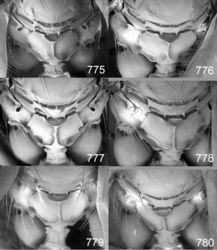Maintenance
All wikis at Biowikifarm are in read-only mode due to the restoration after a severe cyberattack in October 2023.
After 1 year being shut down the Biowikifarm is online again.
You see the latest restored version from 18th October 2023.
Euplectrus paulheberti
| Notice: | This page is derived from the original publication listed below, whose author(s) should always be credited. Further contributors may edit and improve the content of this page and, consequently, need to be credited as well (see page history). Any assessment of factual correctness requires a careful review of the original article as well as of subsequent contributions.
If you are uncertain whether your planned contribution is correct or not, we suggest that you use the associated discussion page instead of editing the page directly. This page should be cited as follows (rationale):
Citation formats to copy and paste
[Expand] |
Ordo: Hymenoptera
Familia: Eulophidae
Genus: Euplectrus
Name
Euplectrus paulheberti Hansson sp. n. – Wikispecies link – ZooBank link – Pensoft Profile
Material
Holotype a female labeled “COSTA RICA: Guanacaste, ACG, Sector Santa Rosa, Area Administrativa, 8.x.2013, W. Hallwachs, ex Aellopos clavipes eating Randia aculeata, sibling of wasp DHJPAR0053133, 13-SRNP-10107” (BMNH). Paratypes: 8♀ 2♂ with same label data as holotype (BMNH, CNC, INBio, MZLU, USNM).
Diagnosis
Lower face completely pale, in female medially yellowish-brown and laterally yellowish-white (Fig. 496), in male white (Fig. 497); fore and mid legs yellowish-white; hind leg yellowish-brown (Fig. 495); petiole 1.0× as long as wide in female, 0.8× in male; gaster with anterior ½ yellowish-white with lateral margins dark brown posterior ½ dark brown (Fig. 498); male scape slightly enlarged (Fig. 501), widest medially, 2.9× as long as wide.
Description
Female. Length of body 1.8 mm. Antenna with scape yellowish-white, pedicel and flagellomeres 1–2 yellowish-brown, flagellomeres 3–6 dark brown (Fig. 500). Mandibles and palpi white. Head black and shiny, lower face completely pale, medially yellowish-brown and laterally yellowish-white (Fig. 496). Frons close to eyes with a row of setae (Fig. 506). Vertex with very weak reticulation (Fig. 507). Occipital margin with a carina behind ocellar triangle (Fig. 507).
Mesosoma black and shiny (Fig. 495). Scutellum 1.0× as long as wide; with very weak reticulation (Fig. 508). Dorsellum along anterior margin with a deep groove that is divided by longitudinal carinae (Fig. 777), groove medially 0.4× as long as length of dorsellum. Propodeum with very weak reticulation partly smooth (Fig. 777); anteromedially with a semicircular cup that is strongly raised in posterior part; propodeal callus with eight setae. Legs (Fig. 495): fore and mid legs yellowish-white; hind leg yellowish-brown. Fore wing: costal cell with one row of setae on ventral surface, and margin with two setae close to marginal vein; with 14 admarginal setae.
Gaster with anterior ½ yellowish-white with lateral margins dark brown posterior ½ dark brown (Fig. 498).
Ratios. HE/MS/WM = 2.1/1.0/1.3; POL/OOL/POO = 5.9/3.0/1.0; OOL/DO = 1.3; WE/WF/WH/HH = 1.0/2.3/4.3/3.0; WH/WT = 1.2; PM/ST = 1.5; TS1/TS2/LT/LT1/LT2/LT3/LT4 = 4.7/3.8/8.4/3.3/1.8/1.0/1.8; LP/WP = 1.0; MM/LG = 1.3.
Male. Length of body 1.5 mm. Scape slightly enlarged, widest medially, with sensory pores limited to apical ⅔ of ventral margin, sensory area yellowish-white (Fig. 501). Similar to female except lower face white (Fig. 497), and shorter petiole and gaster.
Ratios. LC/WS = 2.9; LP/WP = 0.8; MM/LG = 1.5.
Hosts and biology
Feeding on second instar larva of Aellopos clavipes (Sphingidae) feeding on Randia aculeata (Rubiaceae), parasitoid cocoons stuck to dead larva and substrate.
Distribution
Costa Rica (Guanacaste Province).
Etymology
This species is named after Paul D. N. Hebert, in recognition of his contribution to the understanding of ACG Hymenoptera taxonomy.
Original Description
- Hansson, C; Smith, M; Janzen, D; Hallwachs, W; 2015: Integrative taxonomy of New World Euplectrus Westwood (Hymenoptera, Eulophidae), with focus on 55 new species from Area de Conservación Guanacaste, northwestern Costa Rica ZooKeys, (485): 1-236. doi
Images
|




